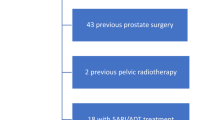Abstract
Since the publication of PI-RADS v1 in 2012, the debate regarding the question of how to manage PI-RADS 3 lesions has been mostly unsolved. However, based on our review of the current literature we discuss possible solutions and improvements to the original classification, factors such as PSAD (Prostate Specific Antigen Density), age, and tumor volume, in the decision of whether to proceed with a biopsy or not.
Graphical abstract




Similar content being viewed by others
References
Turkbey B, Rosenkrantz AB, Haider MA, Padhani AR, Villeirs G, Macura KJ, Tempany CM, Choyke PL, Cornud F, Margolis DJ, Thoeny HC, Verma S, Barentsz J, Weinreb JC (2019) Prostate Imaging Reporting and Data System Version 2.1: 2019 Update of Prostate Imaging Reporting and Data System Version 2. Eur Urol 76 (3):340-351. doi:https://doi.org/10.1016/j.eururo.2019.02.033
Yang S, Zhao W, Tan S, Zhang Y, Wei C, Chen T, Shen J (2020) Combining clinical and MRI data to manage PI-RADS 3 lesions and reduce excessive biopsy. Transl Androl Urol 9 (3):1252-1261. doi:https://doi.org/10.21037/tau-19-755
van der Leest M, Israel B, Cornel EB, Zamecnik P, Schoots IG, van der Lelij H, Padhani AR, Rovers M, van Oort I, Sedelaar M, Hulsbergen-van de Kaa C, Hannink G, Veltman J, Barentsz J (2019) High Diagnostic Performance of Short Magnetic Resonance Imaging Protocols for Prostate Cancer Detection in Biopsy-naive Men: The Next Step in Magnetic Resonance Imaging Accessibility. Eur Urol 76 (5):574-581. doi:https://doi.org/10.1016/j.eururo.2019.05.029
Zawaideh JP, Sala E, Shaida N, Koo B, Warren AY, Carmisciano L, Saeb-Parsy K, Gnanapragasam VJ, Kastner C, Barrett T (2020) Diagnostic accuracy of biparametric versus multiparametric prostate MRI: assessment of contrast benefit in clinical practice. European radiology 30 (7):4039-4049. doi:https://doi.org/10.1007/s00330-020-06782-0
Liddell H, Jyoti R, Haxhimolla HZ (2015) mp-MRI Prostate Characterised PIRADS 3 Lesions are Associated with a Low Risk of Clinically Significant Prostate Cancer - A Retrospective Review of 92 Biopsied PIRADS 3 Lesions. Curr Urol 8 (2):96-100. doi:https://doi.org/10.1159/000365697
Schlenker B, Apfelbeck M, Armbruster M, Chaloupka M, Stief CG, Clevert DA (2019) Comparison of PIRADS 3 lesions with histopathological findings after MRI-fusion targeted biopsy of the prostate in a real world-setting. Clin Hemorheol Microcirc 71 (2):165-170. doi:https://doi.org/10.3233/CH-189407
Wadera A, Alabousi M, Pozdnyakov A, Kashif Al-Ghita M, Jafri A, McInnes MD, Schieda N, van der Pol CB, Salameh JP, Samoilov L, Gusenbauer K, Alabousi A (2021) Impact of PI-RADS Category 3 lesions on the diagnostic accuracy of MRI for detecting prostate cancer and the prevalence of prostate cancer within each PI-RADS category: A systematic review and meta-analysis. The British journal of radiology 94 (1118):20191050. doi:https://doi.org/10.1259/bjr.20191050
Distler FA, Radtke JP, Bonekamp D, Kesch C, Schlemmer HP, Wieczorek K, Kirchner M, Pahernik S, Hohenfellner M, Hadaschik BA (2017) The Value of PSA Density in Combination with PI-RADS for the Accuracy of Prostate Cancer Prediction. The Journal of urology 198 (3):575-582. doi:https://doi.org/10.1016/j.juro.2017.03.130
Wei X, Xu J, Zhong S, Zou J, Cheng Z, Ding Z, Zhou X (2022) Diagnostic value of combining PI-RADS v2.1 with PSAD in clinically significant prostate cancer. Abdom Radiol (NY) 47 (10):3574–3582. doi:https://doi.org/10.1007/s00261-022-03592-4
Bittencourt LK, Guricova K, Zucker I, Durieux JC, Schoots IG (2022) Risk-based MRI-directed diagnostic pathway outperforms non-risk-based pathways in suspected prostate cancer biopsy-naive men: a large cohort validation study. European radiology 32 (4):2330-2339. doi:https://doi.org/10.1007/s00330-021-08407-6
Liu J, Dong B, Qu W, Wang J, Xu Y, Yu S, Zhang X (2020) Using clinical parameters to predict prostate cancer and reduce the unnecessary biopsy among patients with PSA in the gray zone. Sci Rep 10 (1):5157. doi:https://doi.org/10.1038/s41598-020-62015-w
Sheridan AD, Nath SK, Syed JS, Aneja S, Sprenkle PC, Weinreb JC, Spektor M (2018) Risk of Clinically Significant Prostate Cancer Associated With Prostate Imaging Reporting and Data System Category 3 (Equivocal) Lesions Identified on Multiparametric Prostate MRI. AJR American journal of roentgenology 210 (2):347-357. doi:https://doi.org/10.2214/AJR.17.18516
Fang AM, Shumaker LA, Martin KD, Jackson JC, Fan RE, Khajir G, Patel HD, Soodana-Prakash N, Vourganti S, Filson CP, Sonn GA, Sprenkle PC, Gupta GN, Punnen S, Rais-Bahrami S (2022) Multi-institutional analysis of clinical and imaging risk factors for detecting clinically significant prostate cancer in men with PI-RADS 3 lesions. Cancer 128 (18):3287-3296. doi:https://doi.org/10.1002/cncr.34355
Rico L, Blas L, Vitagliano G, Contreras P, Rios Pita H, Ameri C (2021) PI-RADS 3 lesions: Does the association of the lesion volume with the prostate-specific antigen density matter in the diagnosis of clinically significant prostate cancer? Urol Oncol 39 (7):431 e439–431 e413. doi:https://doi.org/10.1016/j.urolonc.2020.11.010
Martorana E, Aisa MC, Grisanti R, Santini N, Pirola GM, Datti A, Gerli S, Bonora A, Burani A, Scalera GB, Scialpi P, Di Blasi A, Scialpi M (2022) Lesion Volume in a Bi- or Multivariate Prediction Model for the Management of PI-RADS v2.1 Score 3 Category Lesions. Turk J Urol 48 (4):268–277. doi:https://doi.org/10.5152/tud.2022.22038
Scialpi M, Martorana E, Aisa MC, Rondoni V, D'Andrea A, Bianchi G (2017) Score 3 prostate lesions: a gray zone for PI-RADS v2. Turk J Urol 43 (3):237-240. doi:https://doi.org/10.5152/tud.2017.01058
Turkbey B, Mani H, Aras O, Rastinehad AR, Shah V, Bernardo M, Pohida T, Daar D, Benjamin C, McKinney YL, Linehan WM, Wood BJ, Merino MJ, Choyke PL, Pinto PA (2012) Correlation of magnetic resonance imaging tumor volume with histopathology. The Journal of urology 188 (4):1157-1163. doi:https://doi.org/10.1016/j.juro.2012.06.011
Author information
Authors and Affiliations
Corresponding author
Additional information
Publisher's Note
Springer Nature remains neutral with regard to jurisdictional claims in published maps and institutional affiliations.
Rights and permissions
Springer Nature or its licensor (e.g. a society or other partner) holds exclusive rights to this article under a publishing agreement with the author(s) or other rightsholder(s); author self-archiving of the accepted manuscript version of this article is solely governed by the terms of such publishing agreement and applicable law.
About this article
Cite this article
Nicola, R., Bittencourt, L.K. PI-RADS 3 lesions: a critical review and discussion of how to improve management. Abdom Radiol 48, 2401–2405 (2023). https://doi.org/10.1007/s00261-023-03929-7
Received:
Revised:
Accepted:
Published:
Issue Date:
DOI: https://doi.org/10.1007/s00261-023-03929-7




